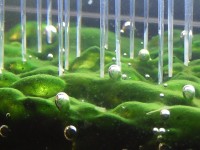|

Colleagues from the University of Wyoming used microelectrodes to measure the pH and dissolved zinc concentrations within biofilm grown in a laboratory aquarium. In this view, one can see the microelectrodes (glass tubes) sticking into a biofilm sample. The results of this work documented that when exposed to light, the biofilm absorbs zinc. Used with permission from Dr. Jeffrey M. Morris, Western Research Institute -- from the Diurnal Metal Variations Photo Gallery
|